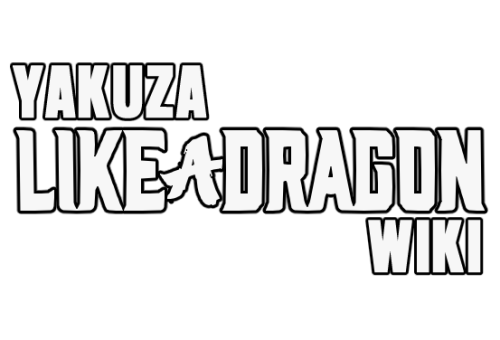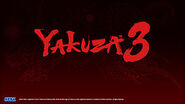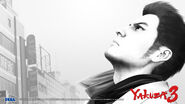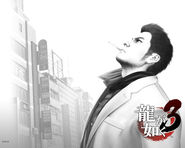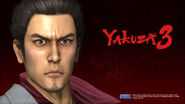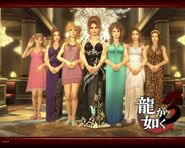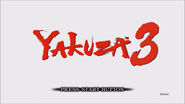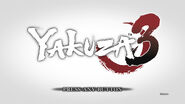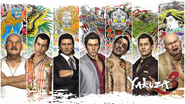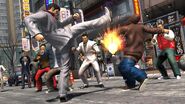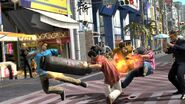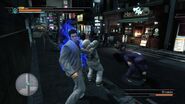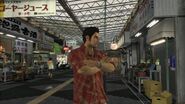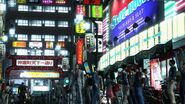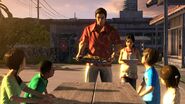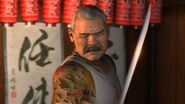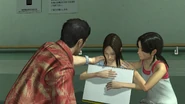Template:Game infobox
— Original Yakuza 3 taglineTHE DRAGON OF DOJIMA RETURNS
Yakuza 3 (龍が如く3, Ryū ga Gotoku 3, lit. "Like a Dragon 3") is an action-adventure/beat-'em-up game originally released for the PlayStation 3 on February 26, 2009 in Japan and South East Asia, and on March 9, 2010, and March 12, 2010 in North America and Europe respectively. The game was developed by CS1 Team (now known as Ryu ga Gotoku Studio) as the third main installment (fourth overall) of the Yakuza series.
A remaster for PlayStation 4, with an improved framerate and resolution running at 1080p and 60fps, was released on August 9, 2018 in Japan. It was released worldwide on August 20, 2019, as a digital download, and is slated to be released physically as a part of the The Yakuza Remastered Collection on February 11, 2020.
Plot
The game's plot begins four months after the ending of the previous game, in march of 2007. Kazuma Kiryu and his adoptive daughter, Haruka Sawamura, are preparing to depart Tokyo and move to Okinawa, where Kiryu will run an orphanage. After bidding goodbye to their various loved ones, Kiryu seeks out Goro Majima to ask him for a favor. He requests that he rejoin the Tojo Clan and help out its newly-appointed sixth chairman, Daigo Dojima, since he fears many of the Clan's veterans will refuse to accept his leadership due to his youth. After Kiryu talks up all the fights he will have to get into to protect Daigo, and after beating him in a fight himself, Majima agrees.
A few months further down the line, Kiryu and Haruka are living in the okinawan city of Ryukyu, running the beachfront Sunshine Orphanage and taking care of eight other children: Taichi, Ayako, Koji, Eri, Mitsuo, Riona, Shiro and Izumi. However, trouble looms when they start getting eviction notices from their landlords, the Ryudo Family, and some of their goons start menacingly loitering outside the orphanage. Kiryu seeks out said Ryudo men, and finds them in Downtown Ryukyu. They are the family's two lieutenants, Rikiya Shimabukuro and Mikio Aragaki. After the confrontation turns hostile, Rikiya challenges Kiryu to a fight and is swiftly defeated, prompting the two lieutenants to introduce Kiryu to their patriarch, Shigeru Nakahara, as well as his own adoptive daughter, Saki, who suffers from post-traumatic mutism after seeing her birth father kill himself and can only communicate through her sketchbook drawings. Nakahara explains to Kiryu that investors from Tokyo are seeking to buy up land in Okinawa for the construction of a beachfront resort, and Nakahara needs his tenants to leave before he can sell the land. Despite a sizeable cash offer to vacate, Kiryu refuses.
In early 2008, the Ryudo Family's lieutenants approach Kiryu once again, but this time with a plea for help. Saki has gone missing and, while a depressed Nakahara is convinced that she left to go back with her birth mother, Rikiya and Mikio fear she may have been kidnapped. After investigating, Kiryu discovers that Saki did meet with her birth mother, but said mother then proceeded to kidnap her and take her to her new boyfriend, Tetsuo Tamashiro, patriarch of the Ryudo's main rivals, the Tamashiro Family. Kiryu confronts Tamashiro and discovers the reason behind the kidnapping: Tamashiro wants the land the Ryudo own so that he can sell it to the Tokyo investors, and he intends to use Saki as blackmail, threatening to kill her if the land isn't given to him. Tamashiro tries to kill Kiryu to send a message, but he is easily beaten. Just after Tetsuo's defeat, Nakahara arrives and is reunited with Saki. Much to his joy, Nakahara sees that while she was being held captive, Saki drew a picture of him where she called him her true father.
In gratitude for his help, Nakahara promises to never evict Kiryu from his land. Much to their surprise, Daigo Dojima visits them both, accompanied by Shoyo Toma, a local politician. Daigo reveals that the Tojo Clan were the investors from Tokyo seeking to buy the land from the Ryudo and the Tamashiro. As it turns out, the Tojo are working with Minister of Defense, Ryuzo Tamiya, to acquire land for the government so they can pass legislation approving the granting of the land to a touristic resort company and the United States government for the construction of a new military base. Daigo apologizes to Kiryu, saying he was unaware that part of the land they were seeking was his, and promises to not let the land acquisition progress as long as Kiryu lives on said land.
Chapters
There are a total of 13 chapters in Yakuza 3, including the prologue.
Original
- Prologue
- Chapter 1: New Beginnings
- Chapter 2: Encounter
- Chapter 3: Power Struggle
- Chapter 4: The Sketched Man
- Chapter 5: War Begins
- Chapter 6: Allies
- Chapter 7: Mad Dog Majima
- Chapter 8: Men and Plots
- Chapter 9: The Ruse
- Chapter 10: Unfinished Business
- Chapter 11: Crisis
- Chapter 12: The End of Ambition
Remaster
- Prologue
- Chapter 1: New Beginnings
- Chapter 2: The Ryudo Encounter
- Chapter 3: Power Struggle
- Chapter 4: The Man in the Sketch
- Chapter 5: The Curtain Rises
- Chapter 6: Gameplan
- Chapter 7: The Mad Dog
- Chapter 8: Conspirators
- Chapter 9: The Plot
- Chapter 10: Unfinished Business
- Chapter 11: Crisis
- Chapter 12: The End of Ambition
Gameplay
Battles
Brawls & Heat Actions
- Combat is still much the same as the previous two entries, with most objects on the streets usable as weapons in brawls. Heat actions and other upgrades are purchaseable with experience points gained as Kiryu levels up.
Chase Battle
- A chase is initiated when an enemy makes a run for it. The "Chase Gauge" on the lower right charts both characters' endurance, and whichever gauge is depleted first loses. In most chase battles, Kiryu is able to tackle his opponent in order to tire them out. This, along with running into objects, depletes the chase gauge faster to ensure Kiryu's victory.
Training and Mentors
- Training with a mentor allows Kiryu to develop new abilities and hone his skills in battle. The following characters are available for Kiryu to train with:
- Mack Shinozuka - A talented photographer who travels the world searching for unique Revelations. He teaches Kiryu about these revelations, as well as offering useful advice regarding "Chase Battles".
- Sotaro Komaki - An old martial arts master who has a dojo in Kamurocho. By passing his trials, Kiryu can obtain a secret Komaki Style ability.
- Shoji Yonashiro - A self-proclaimed 'Weapon Master' in the midst of his travels around the world. He has a personally-made sparring ring on the beach in front of Morning Glory Orphanage. He teaches various weapon handling techniques.
Revelations
- Kiryu is able to learn new Heat Actions by observing and photographing inspiring events around Okinawa and Kamurocho and blogging about it from his cell phone.
Weapons and Armor
- Kamiyama runs a weapon & defense armor tune-up shop called Kamiyama Works located in downtown Ryukyu. By finding "recipies" for him to work from, Kiryu is able to obtain a plethora of different weapons and armor, as well as have them repaired and improved.
Remaster
A remaster of the original Yakuza 3 was released on August 9th, 2018 in Japan, with the western version released digitally just over a year later on August 20th, 2019. It is available as part of the "The Yakuza Remastered Collection" pack, containing remasters of Yakuza 3, 4, and 5, with the latter two scheduled to be released in October 2019 and February 2020 respectively. The trilogy will also be available as a limited-edition physical box-set, scheduled for release on February 11, 2020. The remastered version has a number of differences compared to the original:
- Gameplay is now in 1080p at 60 frames per second, although the standard PS4 crops the window to 1850x1040 pixels as with the Dragon Engine games. Also, full-motion video sequences have not been remastered and continue to have noticeable lossy compression artefacts.
- The quiz minigame, which had been previously cut from the PS3 western release and relied on trivia relevant to '00s Japan, has been excised entirely from all territorial versions.
- A substory that was deemed to be transphobic has also been excised.
- Some of the hostesses were replaced due to the likeness deals with their real-life counterparts having expired.
- Additionally, the licensing agreements with PepsiCo and Unilever were not renewed, leading to the replacement of products such as AXE and Gatorade with generic items. Pepsi NEX bottles are still visible in vending machines however.
- Substory locations are now marked on the map, as they are in more recent games.
- Requirements for earning PlayStation trophies for activities such as defeating X enemies in certain fashions have been eased to make them less time-consuming.
- Kiryu no longer has to be armed with a copy of Tokyo Ishukan to order the "special" meals from eateries.
- The optional "reminiscence" scenes at the beginning of the original Yakuza 3, which contained video from the original PS2 games, were removed.
The western version also features specific enhancements compared to its original counterpart. Namely:
- Aside from the content cut from all versions of the Yakuza 3 remaster, content originally cut from the western version of Yakuza 3, such as hostesses and 21 substories have been reinstated, giving it content parity with the Japanese remaster release.
- The English localization has been updated and brought in line with newer releases.
- Kazuma Kiryu's name on his dialogue boxes now read "Kiryu" as opposed to "Kazuma", and characters refer to him by his family name followed by the appropriate honorific.
- Terms like "Sunshine Orphanage" has been replaced with Morning Glory Orphanage, and both "Shintaro Fuma" and "Joji Fuma" have been replaced with the correct Shintaro Kazama and Joji Kazama.
- Terminology such as "aniki" has been kept in-tact; as such, Rikiya no longer addresses Kiryu incorrectly with the term "boss".
- Almost all of the dialogue has been retranslated, with an entirely more faithful localization than the original.
- The appearance of graphic text overlays in the English release is now in line with the localized system used in other titles. Rather than having the pre-rendered Japanese text overlays with English subtitles, the remastered western version adopts the system of the first two Yakuza games, as well as that of Yakuza 0 onwards, where the Japanese is displayed first, with an English text overlay coming afterwards.
- Text introducing new characters, objectives, and enemies is now displayed fully in English.
Trivia
- The artwork for the original German release of Yakuza 3 on PlayStation 3 shifted Kazuma Kiryu's face to the right so that it would not be obscured by the USK rating symbol, which is considerably larger than the PEGI, CERO, and ESRB equivalents.
Gallery
Official Art
Screenshots
Template:Games Navigation Bar
